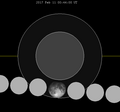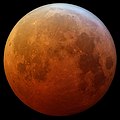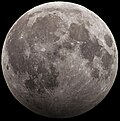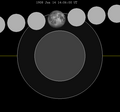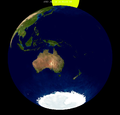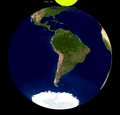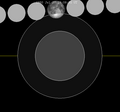Top Qs
Timeline
Chat
Perspective
August 2016 lunar eclipse
Extremely short lunar eclipse From Wikipedia, the free encyclopedia
Remove ads
A penumbral lunar eclipse occurred at the Moon’s descending node of orbit on Thursday, August 18, 2016,[1] with an umbral magnitude of −0.9925. A lunar eclipse occurs when the Moon moves into the Earth's shadow, causing the Moon to be darkened. A penumbral lunar eclipse occurs when part or all of the Moon's near side passes into the Earth's penumbra. Unlike a solar eclipse, which can only be viewed from a relatively small area of the world, a lunar eclipse may be viewed from anywhere on the night side of Earth. Occurring about 3.4 days before perigee (on August 21, 2016, at 21:20 UTC), the Moon's apparent diameter was larger.[2]
The HM National Almanac Office's online canon of eclipses lists this event as the last eclipse on Saros Series 109,[3] while NASA lists August 8, 1998 as the last eclipse of the series, and has this event missing the shadow.[4]
This eclipse grazed the northern boundary of the Earth's penumbral shadow. The event lasted 33 minutes and 36 seconds, beginning at 9:25 UTC and ending at 9:59. This produced a maximum penumbral magnitude of 0.0166.[5] Eclipses of such small magnitudes are visually imperceptible; a penumbral magnitude of approximately 0.6 is required for even skilled observers to detect.[6]
Remove ads
Background
Summarize
Perspective
The Earth's penumbral shadow is larger than would be expected from simple geometry, a phenomenon first observed by Philippe de La Hire in 1707. The precise amount of enlargement varies over time for reasons which are not fully understood, but likely involve the amount of dust in certain layers of the Earth's atmosphere.[7] Various eclipse almanacs have used different assumptions about the magnitude of this effect, resulting in disagreement about the predicted duration of lunar eclipses or, in the case of penumbral eclipses of very short duration, whether the eclipse will occur at all.[8]
In 1989, NASA published a lunar eclipse almanac that predicted a short penumbral lunar eclipse to occur on 18 August 2016. However, the French almanac Connaissance des Temps used more conservative assumptions about the size of the Earth's shadow and did not predict an eclipse to occur at all.[8] The Bureau des Longitudes in France continued to refine their lunar eclipse models; NASA's 2009 edition of its lunar eclipse almanac was based on their values,[9] which effectively reclassified nine eclipses between 1801 and 2300 as non-events, including the one in August 2016.[a][10]
Some resources, including the HM Nautical Almanac Office's online canon of eclipses, continued to list the 18 August 2016 event. Despite not appearing in NASA's printed lists of eclipses since the 2009 revision, AccuWeather reported the upcoming eclipse and projected this was the final member of Lunar Saros 109.[11]
Remove ads
Visibility
The eclipse was completely visible over Australia, North and South America, and Antarctica, seen rising over western Australia and northeast Asia and setting over eastern North and South America.[12]
 |
 Hourly motion shown right to left |
Eclipse season
This eclipse is part of an eclipse season, a period, roughly every six months, when eclipses occur. Only two (or occasionally three) eclipse seasons occur each year, and each season lasts about 35 days and repeats just short of six months (173 days) later; thus two full eclipse seasons always occur each year. Either two or three eclipses happen each eclipse season. In the sequence below, each eclipse is separated by a fortnight. The first and last eclipse in this sequence is separated by one synodic month.
Related eclipses
Summarize
Perspective
Eclipses in 2016
- A total solar eclipse on March 9.
- A penumbral lunar eclipse on March 23.
- A penumbral lunar eclipse on August 18.
- An annular solar eclipse on September 1.
- A penumbral lunar eclipse on September 16.
Metonic
- Followed by: Lunar eclipse of June 5, 2020
Tzolkinex
- Preceded by: Lunar eclipse of July 7, 2009
Tritos
- Followed by: Lunar eclipse of July 18, 2027
Lunar Saros 109
- Preceded by: Lunar eclipse of August 8, 1998
Inex
- Preceded by: Lunar eclipse of April 14, 1987
- Followed by: Lunar eclipse of March 3, 2045
Triad
- Followed by: Lunar eclipse of June 20, 2103
Lunar eclipses of 2016–2020
This eclipse is a member of a semester series. An eclipse in a semester series of lunar eclipses repeats approximately every 177 days and 4 hours (a semester) at alternating nodes of the Moon's orbit.[13]
The penumbral lunar eclipses on March 23, 2016 and September 16, 2016 occur in the previous lunar year eclipse set, and the penumbral lunar eclipses on June 5, 2020 and November 30, 2020 occur in the next lunar year eclipse set.
Saros 109
This eclipse is a part of Saros series 109, repeating every 18 years, 11 days, and containing 71 or 72 events (depending on the source). The series started with a penumbral lunar eclipse on June 27, 736 AD. It contains partial eclipses from September 22, 880 AD through April 16, 1223; total eclipses from April 27, 1241 through October 17, 1529; and a second set of partial eclipses from October 28, 1547 through May 22, 1872. The series ends at member 71 as a penumbral eclipse on August 8, 1998, though some sources count a possible penumbral eclipse on August 18, 2016 as the last eclipse of the series.
The longest duration of totality was produced by member 35 at 99 minutes, 45 seconds on July 1, 1349. All eclipses in this series occur at the Moon’s descending node of orbit.[14]
Eclipses are tabulated in three columns; every third eclipse in the same column is one exeligmos apart, so they all cast shadows over approximately the same parts of the Earth.
Inex series
This eclipse is a part of the long period inex cycle, repeating at alternating nodes, every 358 synodic months (≈ 10,571.95 days, or 29 years minus 20 days). Their appearance and longitude are irregular due to a lack of synchronization with the anomalistic month (period of perigee). However, groupings of 3 inex cycles (≈ 87 years minus 2 months) comes close (≈ 1,151.02 anomalistic months), so eclipses are similar in these groupings.
Remove ads
See also
Notes
- The others are: 22 April 1864, 21 June 1872, 26 October 1882, 21 February 1951, 28 October 2042, 7 March 2194, 30 April 2219, and 18 February 2288.
References
Bibliography
Wikiwand - on
Seamless Wikipedia browsing. On steroids.
Remove ads








